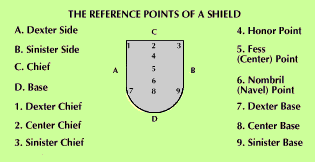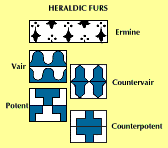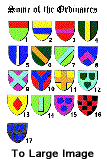|
Heraldry gets its name from the heralds who were the official representatives of kings and lords. It was the herald's duty to keep track of family relationships and of the intricate etiquette governing coats of arms. Heraldry is a system of hereditary identification using visual symbols called coats of arms, or armorial bearings. In origin, armorial bearings consisted of a variety of conventional devices, or charges, displayed on the shield, or escutcheon, of the medieval knight. The practice of displaying the same emblem on the knight's surcoat, or tabard, the tunic worn over his armor, gave rise to the expression coat of arms. The use of such symbols, which became increasingly elaborate, soon spread beyond the military field. Thus, the study of heraldry covers the origin, development, and significance of coats of arms and the official regulation of their use by individuals, families, political units, and social organizations.
The use of symbols of identification, or insignia, is common in primitive societies, where all or most of the population is illiterate. In medieval Europe, however, such emblematic identification became a highly complicated science, the roots of which predate AD 1000. There is evidence that the Vikings used a galley in full sail as an emblem, and many of the Scottish clans, or tribes, used the device of the lion. The horse was a symbol found among both the Anglo-Saxons and the Saxons of Germany, whereas the eagle, which is associated with Charlemagne, became a widespread symbol in Germany. All these emblems predate formal heraldry, but they later passed into heraldic use. Heraldry itself dates from the beginning of the 12th century, when coats of arms began to appear and were adopted rapidly throughout Western Europe. These symbols were developed because of the military necessity of identifying armor-clad warriors, whose faces were covered by helmets. Because of the Crusades, in which men of many nationalities were involved, the idea of heraldic identification spread readily among the nobility of Western Europe. Because the majority of the nobles could not write, their coats of arms were soon incorporated into the design of the wax seals with which they stamped letters and documents. Within a short time coats of arms were adopted for the same purpose by clerics, lawyers, and the heads of corporations such as colleges, merchant companies, and towns. Although heraldry started in the noble classes, in some countries (such as Germany, the Low Countries, Italy, and Scandinavia) it came to be used by the burghers, giving rise to non-noble, or burgerlich, arms. In the cities of Italy and in the Alpine regions, patricians--who were accorded equal status with the landed nobility, although not descended from them--also adopted the use of heraldry. Basic Description Heraldry became systematized early in its history and developed a specialized vocabulary called blazon to describe the devices used. In the British Isles the vocabulary of blazon was derived from Norman French with much borrowing from other languages. Shields came in various shapes. Common Shield Shapes.  For descriptive purposes the shield-shaped field, or ground, of the coat of arms is divided into nine areas. The three at the top are called (from viewer's left to right) dexter chief, center chief, and sinister chief; those in the horizontal center, dexter flank, fess point, and sinister flank; and those at the bottom, dexter base, center base, and sinister base. The designations "dexter" (Latin: "right") and "sinister" (Latin: "left") are given from the point of view of the warrior behind the shield.
Superimposed on the field are the charges. The most
common charges are called ordinaries, basic geometric
bands of color such as the fess (a horizontal band across
the central third of the field), the chief (a band
across the top), the pale (a vertical band down the central
third), the bend (a wide diagonal band), the bar
(a horizontal band one-fifth the depth of the shield), and the
chevron (an inverted V). Also called ordinaries --
or by some experts, subordinaries -- are such less-common
shapes as the cross, the saltire (a diagonal cross),
the pile (a triangular wedge from the top), the billet
(a small rectangle), the bordure (a narrow
border), the orle (a border set in from the edge), and
the inescutcheon (an inner shieldlike shape), among many
others. Many of these charges appear in multiple and diminutive
form, in which case they are called barry, bendy, paly,
or by the appropriate plural form. In addition to the ordinaries are a myriad of other charges that depict both animate and inanimate objects. Animals such as lions, eagles, dolphins, and boars appear in profusion and with many different attitudes. Mythical animals (for example, the dragon and griffin), trees and flowers, ships, and weapons are also common. Certain technical terms are used to describe the attitudes of animals that appear in coats-of-arms. When the animal is shown with its forelegs raised it is said to be rampant. Seen side faced, it is rampant displayed; seen full faced, rampant guardant; looking back, rampant reguardant; sitting, rampant sejant. When the animal is shown as though it were walking it is described as passant; when it is lying down with its head up, couchant; when it is almost rampant, but in a leaping or springing position, it is salient.
The partition lines need not be straight; variations include indented, wavy, engrailed, invected, embattled, and nebule lines. The process by which arms are combined to show matrimonial and other alliances is called marshaling. Marriage is usually shown by impalement, in which the shield is divided vertically, with the husband's arms in the dexter half and the wife's in the sinister. Their children might use both sets of arms on a quartered shield, with the arms repeated diagonally. Cadency is the name given to the modifications made to differentiate various branches and members of a family entitled to bear the same coat of arms. There are two systems. Major brisures, which involve changes of charges or tinctures or the addition of ordinaries, indicate different branches of a family. They were used in Scotland and continental Europe, except Germany. In England, the use of major brisures was discontinued in the 15th century, when the Wars of the Roses virtually eliminated the old families. The English, therefore, came to use only minor brisures -- small symbols added to designate the position of a member within the nuclear family. For example, the symbol of the first son is a label (a narrow strip with three pendants); that of the second, a crescent; that of the third, a mullet (five-pointed star); and that of the fourth, a martlet (mythical bird). The Armorial Achievement As time passed the armorial bearings began to include elements other than the shield. Helmets took varying shapes to indicate the rank of the warrior, and at the beginning of the 14th century English knights began to wear distinctive crests on their helmets. Although originally restricted to knights of tournament rank, crests soon became widespread and, in most heraldic jurisdictions, were granted with coats of arms. Originally these crests were borne directly on the helmet, but distinctions emerged. The crests of knights were borne on wreaths of the livery colors; magnates often had a crest coronet; and some (in Scotland, feudal barons) had their crests on a chapeau. The helmet and crest were placed above the coat of arms in the complete grouping of elements, called the armorial achievement. Other elements added over the centuries were mottoes placed below and above the arms and crest; a compartment, some form of ground placed below the shield (in Scotland and France it had special significance); and supporters, usually in animal or human form, which flanked the shield and stood on the compartment. At an early date arms were also placed on flags. |
|
|
 Origin
Origin
 The colors, or tinctures,
of the field are limited to two metals, gold (or)
and silver (argent); five, or sometimes seven, colors,
blue (azure), red (gules), green (vert),purple
(purpure), black (sable), and sometimes sanguine
(murrey) and tawny (tenne); and various furs,
such as ermine (appearing in stylized form as black tails
on a white field) and vair (squirrel; bell shapes of alternating
blue and white). Later a system of lines and dots was adopted
in order to show the tinctures in black and white illustrations.
The colors, or tinctures,
of the field are limited to two metals, gold (or)
and silver (argent); five, or sometimes seven, colors,
blue (azure), red (gules), green (vert),purple
(purpure), black (sable), and sometimes sanguine
(murrey) and tawny (tenne); and various furs,
such as ermine (appearing in stylized form as black tails
on a white field) and vair (squirrel; bell shapes of alternating
blue and white). Later a system of lines and dots was adopted
in order to show the tinctures in black and white illustrations.

 Division of the field is accomplished
by partition lines that often follow the lines of the
ordinaries and are called accordingly per pale, per bend,
and per saltire, for example. The sections thus formed
are of different color, and charges may change color on either
side of the line, thus becoming counterchanged.
Division of the field is accomplished
by partition lines that often follow the lines of the
ordinaries and are called accordingly per pale, per bend,
and per saltire, for example. The sections thus formed
are of different color, and charges may change color on either
side of the line, thus becoming counterchanged.